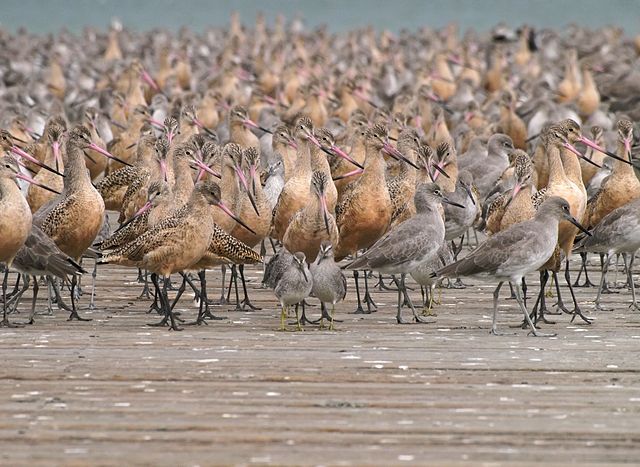
Tucked away on the eastern end of Crown Memorial State Beach stands a small pickleweed salt marsh. This morning, eleven birdwatchers and I gathered to enjoy the winter shorebirds and celebrate local conservationist Elsie Roemer’s birthday and birding legacy. The marsh was teeming with birds in every shade of brown and gray. Stately marbled godwits and long-billed curlews loomed above dunlin, sanderlings and sandpipers, manic flocks emitting their cries. Periodically, the birds took off in well-synchronized squadrons, turning and flashing — first dark, then light — in quick succession. This maneuver was sure to startle and confuse any predators who might be waiting for a bird breakfast buffet. You can read more about our winter residents in my blog about shorebirds for QUEST.
The raucous call of crows diving at a large bird on the building behind us pointed out the red-tailed hawk. It lingered until the mayhem drove it from on high down to the beach. Then a smaller Cooper’s hawk cackled a startled call as it swooped nearby. Perhaps the red-tail was on the Cooper’s favorite perch, best to scope out the neighborhood and mudflats for a birdy breakfast.

Former Alameda resident Elsie Roemer, with us now only in spirit, helped ensure this wonderful salt marsh habitat remained while most of the bay’s marshlands – over 80 percent – were filled, drained, or diked for development like the nearby South Shore Shopping Center. Elsie’s passion for bird watching was kindled late in life, but her enthusiasm impacted many others, especially the young people she mentored. Leora Feeny was among her group, a young mother who moved to Alameda with her family. She helped Elsie with her monthly bird counts that were meticulously submitted to California Department of Fish and Game (now Fish and Wildlife).
Leora recalls, “Elsie was the first to note California least terns at Oakland Airport. She may have been responsible for saving the Northern California population.” Leora also said, “Elsie was among the group who tried to stop the Port of Oakland from filling a seasonal wetland adjacent to MLK Jr. Regional Shoreline. She stood shaking her fist at the bulldozers and shouting strong language – wise words, not profanities as she was a refined woman.”
This group, along with the Golden Gate Audubon, was successful in a lawsuit against the Port that resulted in the new marsh at MLK Jr. Shoreline, an important habitat for resting waterfowl, nesting bird species and burrowing owls.